Hi there, Vladimir Blagojevic here. I am the co-founder at FullFunnel.io and am making a guest appearance on the Terminus blog as a practitioner, to share three account-based marketing campaigns that generated seven-figure pipeline, and were set up in six weeks or less:
- A pilot campaign that generated six opportunities and two sales from 21 target accounts. The campaign was done by one person alone
- A campaign with a 37% reply rate from 30 accounts and six won deals. The campaign was launched with a $5k budget and was executed by one marketer and one SDR
- A virtual event that generated 2320 sign-ups, 34 sales-qualified opportunities, and five new customers right off the bat. The campaign was done by three people, took about month and a half to to prepare, and the cost was completely offset by sales of recorded sessions
Read on to learn the process behind these three campaigns, the biggest ABM myths, and the key elements that made these campaigns successful.
Table of Contents
- Why Use Account-Based Marketing?
- The Biggest ABM Myths
- The 9-Step Behind-The-Scenes Process of Three ABM Campaigns With 6000+% ROI
- Ideal Customer Profile (ICP)
- Account Selection and Disqualification Criteria
- Messaging
- Content
- Warm-up Plays (with 3 example plays)
- Account Research
- Activation Plays (with 3 example plays)
- The Sales Follow-up Play
- Alignment and Buy-in
- Conclusion
Why Use Account-Based Marketing?
Put simply, account-based marketing (ABM) is a focused approach to generate sales opportunities with specific accounts instead of marketing to the entire market. ABM is a good fit for B2B companies selling high-ticket products to mid-level and enterprise customers. This type of sales is usually characterized by long and complex sales cycles involving multiple buyers in target accounts.
While many companies of this type struggle to create marketing programs that impact revenue, ABM has been proven to do exactly that in number of compelling studies:
- Respondents to TOPO’s 2019 ABM benchmarking study indicate that account based improves customer lifetime value (80%), improves win rates (86%), and delivers higher ROI (76%) than a traditional go-to-market approach.
- Organizations report, on average, a 48 percent higher win rate from their account-based efforts, and create opportunities in 21 percent of target accounts (TOPO)
- In a study released by the ABM Leadership Alliance, companies that implemented account-based strategies saw an increase of 171 percent in their average contract value (ACV).
The Biggest ABM Myths
Account-based marketing is gaining popularity, but as many buzzwords, it’s plagued with myths and misconceptions. Myths like:
1. ABM Replaces All Other Marketing Activities
ABM is sometimes perceived as a “silver bullet” that replaces all other marketing activities and becomes a standalone go-to-market strategy.
Why is this a misconception?
Because ABM is just a part of your go-to-market strategy. B2B companies with long and complex sales cycles also need demand generation, inbound marketing, lead nurturing programs, sales enablement and paid acquisition.
These are all part of your go-to-market strategy and shouldn’t be replaced by ABM. Account-based marketing helps you to focus on specific accounts, but it doesn’t mean that you need to stop other campaigns.
In fact, you can combine different approaches.
For example, an article you published as a part of your inbound marketing strategy can generate website traffic. Using IP recognition software you can identify accounts visiting that article. You can then filter the accounts that fit your Ideal Customer Profile, and that have e.g. checked out your product or pricing pages. You can then add some of these companies to one of your ABM plays.
2. ABM Requires an Expensive Tech Stack and a Big Budget
People believe you need deep pockets to start with account-based marketing and create a successful campaign. This is simply not true.
Later in this article, I’ll share campaigns run without a fancy tech stack and with budgets of less than $100 per target account.
Now, as you’re scaling your account-based activity and involving various people from your marketing and sales teams, it makes sense to orchestrate and align everyone using a dedicated ABM software, especially if it’s well integrated with your CRM and marketing automation tools.
3. ABM Requires 100% Personalization of All the Content You Create
You don’t need an army of content writers to top-of-the-funnel content such as articles, blog posts and webinars. Personalization can happen on different levels:
- In your content strategy, you can include content specific for job roles and verticals (such as case studies and reports
- During account activation plays, for a better ROI, it’s recommended to 100% personalize your outreach if you’re reaching out to Tier 1 and Tier 2 accounts
- You can also provide personalized experiences on your website
4. ABM Requires a Big Marketing and Sales Team
You’ve probably read that a successful ABM marketing necessarily requires a head of sales, an account executive, a bunch of SDRs and copywriters, head of marketing, VP of marketing and a lot of other people.
While you can gradually involve more people from your sales and marketing teams as you scale your ABM programs, you can start with teams as small as two people. As you’ll see below, I ran a pilot ABM campaign myself, spending about half a day each week.
5. ABM Means Lead Generation Only
This myth arises from the outdated mindset of companies who believe the sole purpose of marketing is lead generation.
Account based marketing campaigns, on the other hand, may be devoted to other revenue generating opportunities such as deal expansion, churn prevention, pipeline acceleration etc.
The Behind-The-Scenes Process of Three Abm Campaigns With 6000+% ROI
After giving a quick overview of the three campaigns, I’ll dive into the key elements that made these three campaigns successful.
Overview of the Three Campaigns
1. Creative Direct Mail Outreach
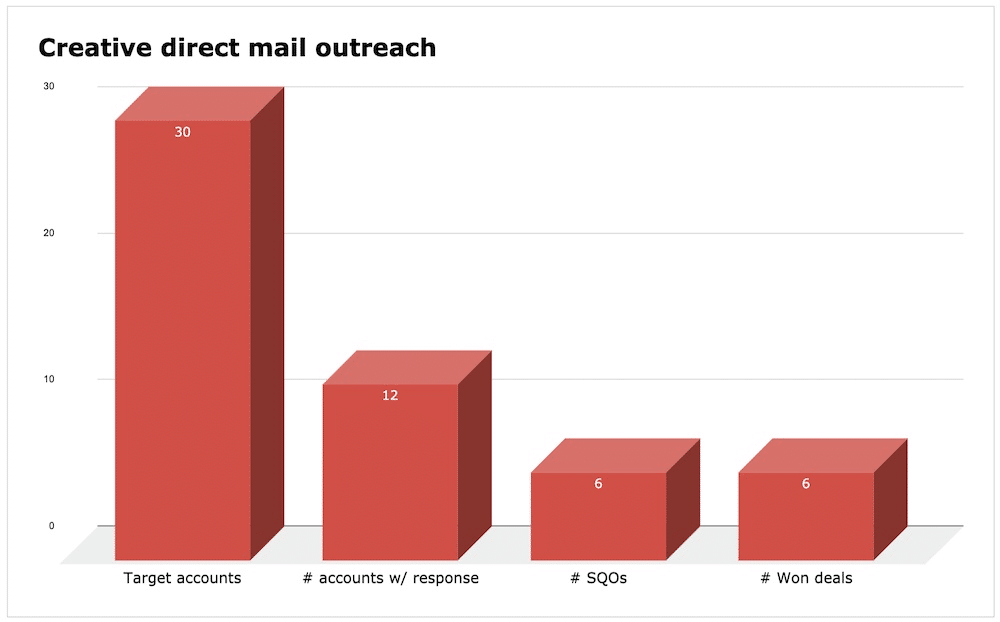
You might be thinking: why go through all the trouble and expense of posting a snail mail? Because in the era of email and LinkedIn spam, direct mail stands out and gets much better response rates (37% accounts responded in this case).
The best part is that half of these responses became qualified sales opportunities. The campaign was run by a marketer, an SDR and a budget of about $5000 — so the campaign ROI was 6000%. If you’re interested, you can take a deep dive in this ABM campaign case study.
2. The Connect & Qualify Pilot Campaign
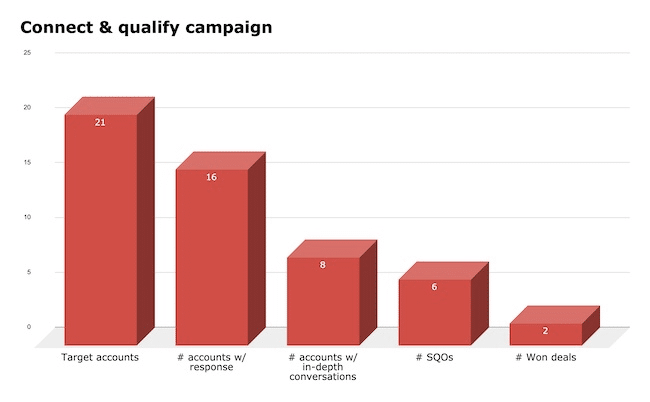
We launched our first “Connect & Qualify” campaign with 21 accounts and about a $300 budget. It took one person about six weeks to run, spending about half a day each week.
Connect & Qualify is an instance of what James Carbarry calls “Content-based networking” in his book with the same title. Essentially, you’re inviting the buyers from your target accounts to co-create content. In this case, we invited our target buyers to appear as guests on our podcast. From the 21 accounts, we got a response from 16 (76%), and 9 accounts agreed to an interview (46%). As a result, we generated six sales-qualified opportunities and closed two sales.
3. The Virtual Event Campaign
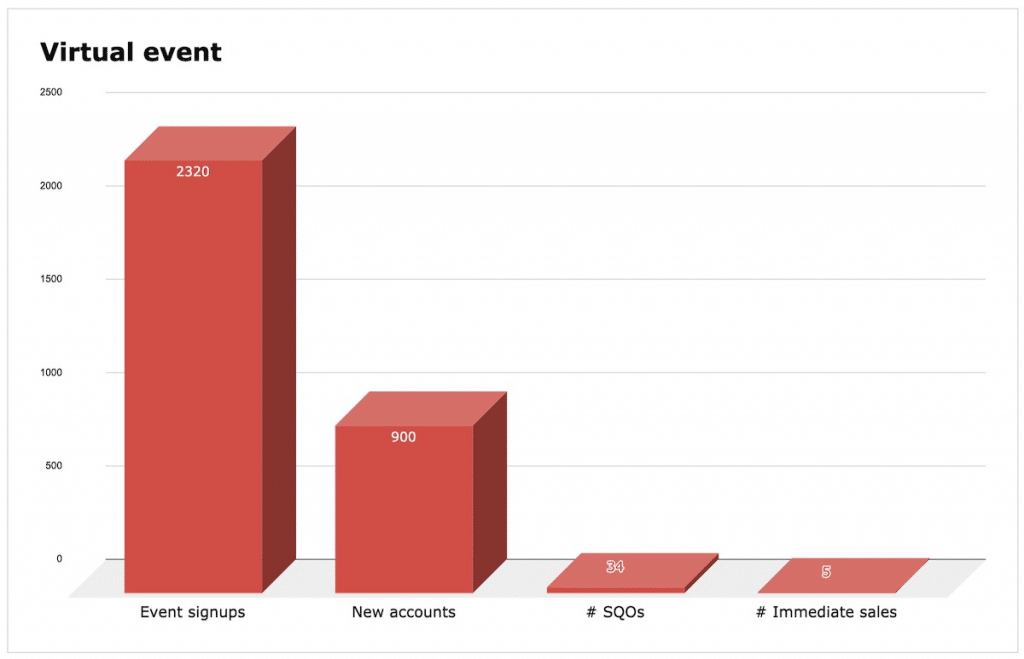
With a client selling smart home hardware and software to system integrator companies in 72 countries, we launched a virtual event in a narrow niche market. The event was a 5-day virtual summit with 35 hours of live-streaming talks by the industry experts.
The event generated 2320 registrations, 34 qualified sales opportunities and five new customers. Since this company has an average sales cycle of about nine months, generating five clients right off the bat was a fantastic result.
The campaign was carried out by three people who worked part-time on this virtual event. The total budget was a few thousand USD — but the budget was completely covered by selling the summit recordings.
The Key Elements That Made These ABM Campaigns Successful
1. Ideal Customer Profile (ICP)
ABM is a focused approach to generate sales opportunities with specific accounts instead of marketing to the entire market. To stack the odds in our favor, we want to:
- Target accounts that are easier to close and bring more revenue and referrals
- Personalize our messaging, content and outreach for the target accounts
The key element that helps us do this is an Ideal Customer Profile (ICP). ICP captures attributes that your best customers from a specific market segment have in common, and describes their buying committee structure, and how they find, evaluate and purchase a product like yours.
Here are example insights from the ICP used in the three campaigns:
- Related strategic goals: international go-to-market
- Challenges: identifying the bottlenecks in their sales and marketing funnel
- Why did you choose us: because of your focus on B2B enterprise SaaS and relevant case studies
- What feature did you like the most and why: developers create the product, you bring the product for developers
- Purchase criteria: healthcare industry knowledge and experience, getting all the skills in one place
- Sourcing: referrals from people in my network, review sites
- Buying committee: Product manager, CTO, senior software engineer, CEO, HR
- Objections and doubts: “Is this going to work?” – case studies helped overcome that doubt
- Social media activity: actively consume content on LinkedIn, post rarely and mainly about company news
2. Account Selection and Disqualification Criteria
Since ABM targets a narrow list of accounts, a key element to align your teams around is the target account list.
You want to avoid situations where sales blame marketing for bad leads and missed sales opportunities. Of where the sales team shares a wish list of accounts — without any evidence that these companies may have the need for your products or services.
That is why it’s a best practice to align your teams around detailed account selection and disqualification criteria:
- Standard attributes such as revenue, team size, sub-industries, locations, tech stack, ad spend, etc.
- Non-standard attributes are specific for your business. E.g., hedging experience (for fintech enterprise SaaS), Mobile SDK (for SDK development company), or complex automation objects in the portfolio (for an installation platform).
- Disqualification criteria are also specific to your business. E.g. SaaS with pricing of <$100 / month; decision maker with sales or marketing background; less than 200 SKUs, etc.
Example account selection and disqualification criteria:
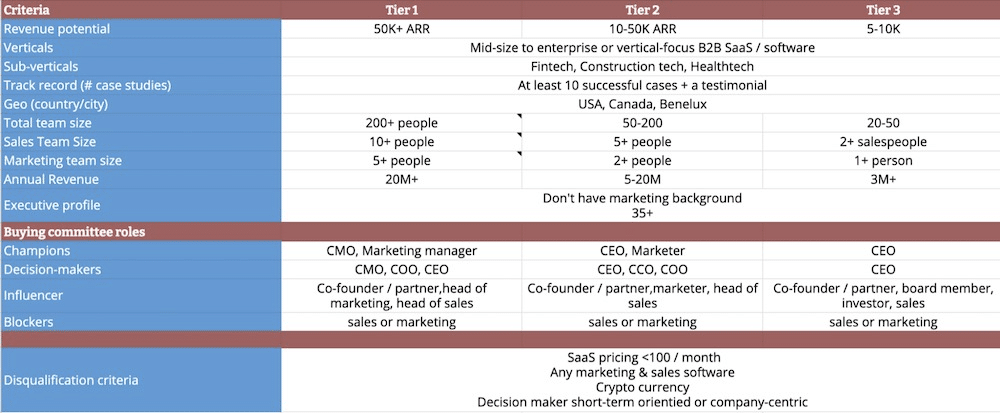
3. Messaging
Imagine you’re a sales manager at a pharmaceutical company. One day, on your LinkedIn feed, you see two different posts:
- “Empower your sales team with sales enablement tools” — with an image of two business people discussing over an iPad
- “Help your reps influence more healthcare providers by becoming their trusted advisors” — this one with an image of a rep discussing with a medical doctor over an iPad
Which one would have you stop and read? I’m guessing the second one. Why? Because it has a better client-message fit. It’s more relevant and it stands out.
You know that there is no such a thing as a one-size-fits-all t-shirt. The same is with messaging. The goal is to tweak your value proposition and other strategic messages to fit the target accounts, vertical and job roles.
Here is the process we follow. Based on ICP interviews, we make a list of value proposition hypotheses for our target vertical. We call them “hypotheses” because we use a validation survey to validate if the value proposition resonates with our clients. For example, for the creative outreach campaign, we used the following survey:
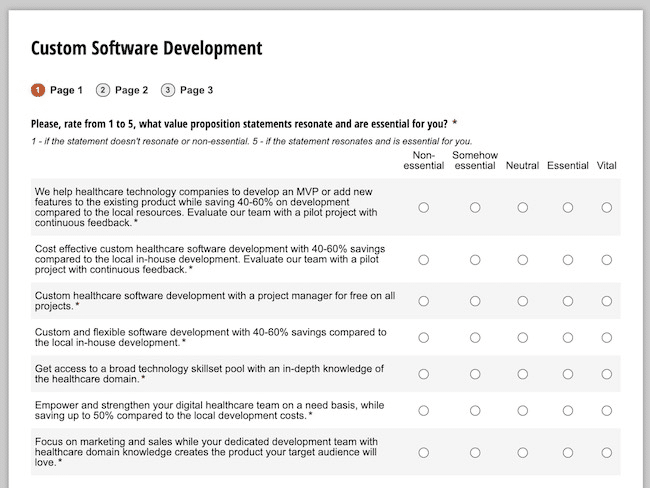
We needed to further refine the value proposition for the different members of the buying journey. What makes sense for the CEO doesn’t usually make sense for software engineers nor HR.

4. Content
Next to strategic messaging, it’s important to (and communicate to the sales team) the content plan and how it can be used to drive engagement with target accounts.
For example, for the Connect & qualify campaign, we prepared the following content:
- Warm-up and invitation scripts
- Scripts for following up with buyers throughout the interview process
- 1-1 personalized outreach letter per target buyer
- Content hub with relevant case studies, description of our process and specific benefits of working with us for our main buying personas (CEO, sales and marketing) – see the example under the “Activation” step
- Since we were inviting people to appear on our podcast, we prepared a dedicated content hub featuring the description of the podcast, interview process and relevant social proof. Here is a screenshot of that content hub
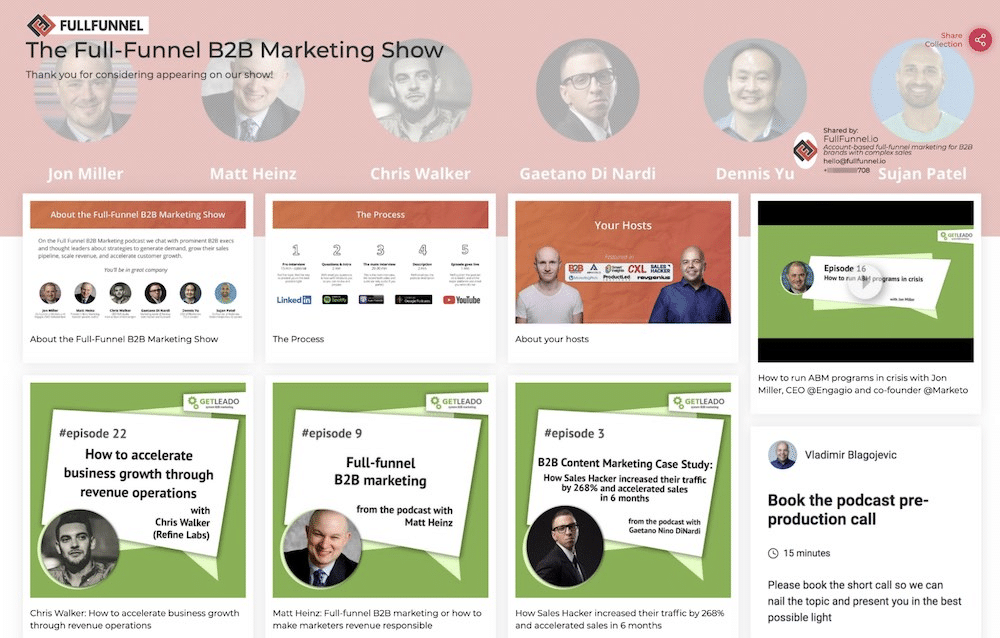
5. Warm-up Plays
People buy from people they know, like and trust. That’s why warming up your accounts before outreach is so effective. Warm-up plays help you avoid reaching out cold. Here are a few examples of warm-up plays:
Example #1: Targeted content distribution
Create awareness and start driving demand with awareness-stage and nurturing content. You can distribute the content using targeted advertising, target communities, or social networks. We like using a “diversified content strategy” on LinkedIn as it allows you to engage different members of the buying committee. A diversified demand generation strategy on LinkedIn means that the different team members use their personal LinkedIn profiles to warm-up and engage different buying committee members of their target accounts.
Example #2: Connect & qualify interviews
The best warm-up plays include interviews with different members of the buying committee. These conversations allow you to build relationships and uncover the target account’s needs, challenges and priorities. We used this in In our Connect & Qualify campaign, we invited our target buyers to appear as guests on our podcast. Another option is to interview them for an article or a market research report. From 21 target accounts, we got a response from 16 (76%), and 9 accounts agreed to an interview (46%).
Example #3: Virtual events
In our virtual event campaign the virtual summit itself gave plenty of opportunities to warm-up target accounts:
- There is a lot of awareness creation during the event promotion. Since in the case of our client, this was the first such event in their industry, it helped them establish themselves as industry thought leaders
- Every time a speaker signs up, this is another opportunity to communicate about it. Our client also carried out podcast interviews with speakers. That allowed them to warm up the market and attendees, featuring speakers and topics they could expect to see at the summit. This also helped spread the news and increase event sign-ups because speakers who appeared on our podcast started to share the interview with their contacts.
- Even if you don’t do podcast interviews, you can have calls with the speakers who fit your ICP to discuss their contribution. These conversations can be used a form of the warm-up play described under the Example #2 above.
- In addition, our client added their own workshops to most days of the program. This allowed them to present themselves and share their expertise.
6. Account Research
Account research allows you to qualify accounts that are more likely to have the need for your product, and personalize your outreach. Here are six pillars of account research:
#1 ICP interviews
Want to understand the goals, triggers and pains of your target accounts? Start by interviewing your existing customers that are most alike your target accounts. The key is to understand how they find, evaluate and purchase a product like yours.
#2 Qualification keywords in employee profiles or job ads
Analyze the profiles of your customers and prospects for common qualification keywords. Use them to find buyers in your target accounts. For example, from customer interviews done by a client, it became clear that an important qualification criterion was their need for a mobile SDK. By looking at our target account’s employees’ profiles and their job ads, we could easily identify if they had this specific need and personalize our outreach.
#3 Target account interviews
Interview buyers from your target accounts as described in the Example #2 of Warm-up plays above. You’ll learn about the account, their needs and the buyers themselves.
#4 Common connections
Talk to partners or shared connections about target accounts’ key initiatives. Ask for an intro.
#5 Intent data
You can leverage intent data sources to identify in-the market accounts, and identify triggers for your outreach.
#6 Press releases, news, product roadmaps, and interviews
Mine the golden nuggets to make your outreach more targeted, timely and relevant. E.g. research showed us that the buyers were not employed by a target account, but a company they recently acquired. If we didn’t discover this, we’d be looking for buyers at the wrong place.
#7 Personal profile research
Look for account insights — but also personal hobbies, interests, university, hometown… This info becomes useful for personalized proposals we’ll tackle in the next section.
7. Activation Plays
Running an ABM campaign without an activation play is like folding on a royal flush. You’re leaving a lot of money on the table. Here are two examples of activation plays we used in our campaigns.
Example #1: Creative outreach via direct mail
We reached out to the different members of the buying committee in our target accounts (product manager, CTO, senior software engineer, CEO, HR). Our physical parcel included:
- Personalized outreach letter
- Grabbers (small gifts personalized to the role)
- Detailed service description
- Company’s presentation
- Portfolio
- Niche case study (same vertical)
You might be wondering why we decided to purchase personalized gifts. This is a crucial step that ensures that mail gets opened, and your letter read. E.g. “What do cycling and B2B sales have in common?” That’s how I opened my proposal letter to a CEO who’s into alpine cycling. The letter came with a copy of a beautiful “Mountains, Epic Cycle Climbs” book.
This was an example of 100% personalization, which is advised for Tier-1 accounts. We used this for Connect & Qualify campaign and had a 100% response rate. In these 1-1 personalized letters, we didn’t write about general pains we can solve. Instead, we used the insights we’ve gained in our research and interviews, and spoke to their specific goals, challenges and priorities. The minimal level of personalization is per vertical and role, which is what we did for the Creative Direct Mail Outreach campaign, where we had a 37 percent response rate.
Example #2: Activation webinars
The main activation play in the Virtual event campaign was an activation webinar for Tier 1 and Tier 2 accounts that attended the event. Once the event was finished, we analyzed the signups to identify new accounts that fit their ideal customer profile. We then sent the attendees from these accounts manual, personalized invitations via email and SMS text messages. To increase attendance in the activation webinar, the sales team also invited some attendees by phone, because the sign-up form for the main event contained a phone number field.
Example #3: Activation during interviews
While running warm up plays like interviews in the Connect & Qualify campaign, it’s really important NOT to use the interviews to pitch your product. People hate the “bait and switch” approach, and you can lose their trust by doing that. However, the interview may give you an opening for a soft pitch. Let me share two concrete examples.
For example, your guest may ask to know more about what you do. This is an opportunity to share your value proposition and ask if they’d like to learn more in a separate call. Or, the prospect could mention a specific challenge you know you can help them with. You could mention a case study with a client in a similar situation, and offer to tell them more in a separate call.
8. The Sales Follow-up Play
This is a critical campaign step that is often missed. But it is during the sales follow-up that the majority of opportunities get created. In addition, the conversations provide direct qualitative feedback on your approach that you can use to tweak future campaigns.
For example, in the Creative Direct Mail Outreach campaign, we started the follow-up the day after the parcels were delivered. We prepared a script for the phone call and trained the sales team on how to overcome sales objections. In essence, the call starts by checking if they received the parcel and if they had a chance to review the attached proposal – and naturally flows into discussing the fit.
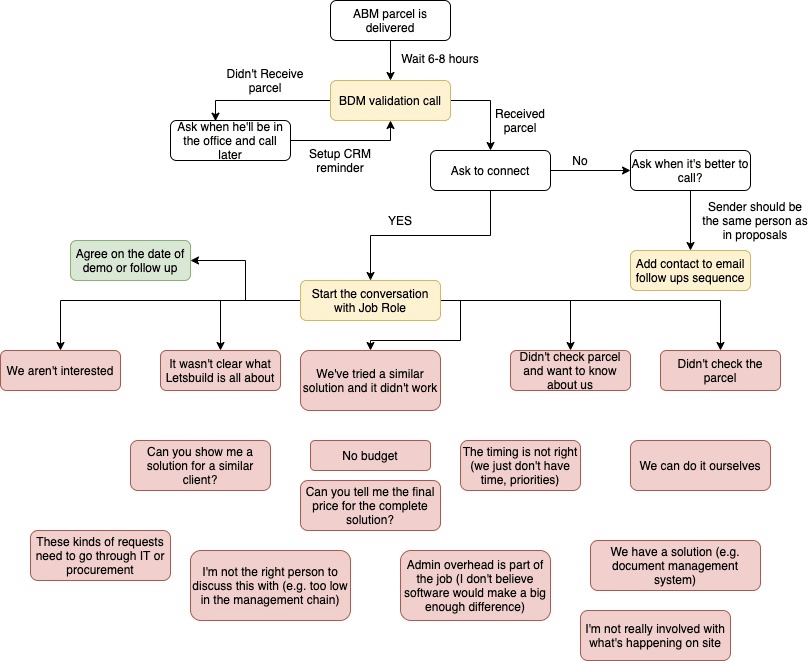
9. Alignment and Buy-in
The key to a successful campaign is marketing and sales alignment and getting the buy-in from both the sales and the executive team. Unfortunately, most of the time, marketing is doing things that sales are not aware of and vice versa. And this is the surefire way to fall short of the ABM goals. There are five critical points to align, in order to run a successful account-based marketing campaign:
#1: Ideal Customer Profile and account selection and disqualification criteria
You want to avoid the situation where sales rejects the leads marketing is generating, or where the sales gives to marketing a wish list of accounts or lost deals. That is why marketing and sales should be aligned on ideal customer profile and account selection criteria — and eventually the target list of accounts and members of the buying committee.
#2: Campaign goals
It is important to clearly communicate the goals of the ABM campaign and align it with strategic goals of the business. Possible account-based marketing goals include: Generating pipeline / sales opportunities Deal expansion within existing accounts Activation of e.g. frozen deals Retention (renewals) New market penetration
#3: Messaging and content
It is key to align with sales on the messaging to be used for the target accounts, and the content that can be used to drive engagement with target accounts.
#4: Warm-up and activation plays
Your sales team should be aware of what is being done on the marketing side to warm up and activate the target accounts — and what their role exactly is. You should shara the detailed playbooks, and work with sales on preparing and training the reps involved in the sales follow-up play.
#5: Engagement scoring for leads hands-off
Marketing is more than just sending people who downloaded gated content or newsletter subscribers to sales as leads. Content download is not a signal of buying intent. Otherwise, they would have reached out or booked a demo with your sales team.
It is therefore critical to define engagement scores and distinguish between engagement and buying intent signals, and determine when exactly the prospects would be handed over to sales. In addition, all the information about the target account interactions, marketing activities and insights gained from account research should be shared with SDRs involved in sales follow up or AEs involved in opportunity development. Next to sharing the above information with sales and executives, simplify the buy-in process for stakeholders by forecasting funnel conversion and expected ROI, and comparing it to other recent campaigns. For example:

Conclusion
As you could see from the three examples shared in this article, running effective account-based marketing campaigns doesn’t require huge budgets, a complex tech stack or big teams.
In fact, a pilot campaign similar to the ones I described can be launched in as little as six weeks and run by two people (e.g. a marketer and an SDR).
The campaigns I shared had an ROI of 6000% and more.
I hope that the examples and the brief plan I shared with you will be helpful to set up a similar campaign for your business.